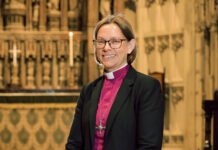The Archbishop today [12 July 2021] addressed General Synod on the Vision and Strategy for the Church of England in the 2020s. The speech follows in full…
Discerning a vision and strategy for the Church of England in the 2020s began with a simple question: what kind of Church is God calling us to become?
After a wide ranging series of conversations involving many Synod members, representatives of just about every constituency that makes up the complex and varied ecology of the Church of England, and many voices that do not always find themselves invited to the decision-making table, we were led to a simple answer: to be a more Christ centred church.
I don’t think we would have arrived at such a simple statement were it not for the experience of Covid. The restrictions and isolations we have lived with have been hard. Our world is suffering. But stripped of the familiar comforts of worship and common life we have discovered a new and clear vision of Christ, the one who stands at the centre of our faith, the one in whom we have access to God. This is ludicrously obvious. It is hardly a surprise to say that our life is centred in Christ. It is unceasingly profound. The new life we have in Christ is received in one ‘gigantic gulp of grace’, as St. Cyprian put it. It is also a never ending story. St John’s Gospel ends with the declaration that if everything about Jesus was written down then “the world itself could not contain the books that would be written” (John 21. 25)
St John also tells us that we are called to beloved discipleship, ‘dwelling close to the Father’s heart’; and courageous discipleship: ‘As the Father sent me, so now I send you’. As we recover and emerge from Covid, we believe that God is asking us to become a church of missionary disciples; a younger and more diverse church that looks like the communities it serves; a safe church and a church that is a place of welcome for everyone; a mixed ecology church where we reach and serve our nation in many different ways.
At the centre of this, and as the means whereby we will serve and reach our nation, is a parish system revitalised for mission. And I’m dismayed that anyone would think this work – work, by the way, that is still a work in progress – is aiming at anything else.
Of course we want to cherish and develop our ministry in chaplaincies, church schools, fresh expressions, church plants, and it is a long time since the Church of England was so positive about the importance of chaplaincy. And , yes, we are setting ambitious targets of how we will reach and serve children and young people and develop new Christian communities. But we also know that these things – as the paper makes clear – will flow from parish churches serving local communities forming communities of faith and enabling every member of the Church of England to discover their part in God’s mission. Even where some services or mission initiatives are lay led, they remain under the oversight of the local incumbent whose cure of souls is shared by the bishops and governed by Canon Law. None of this changes.
Therefore, in the paper before you, particularly in Part Three, you see not only the three strategic priorities for the 2020s, but also the six bold outcomes (three of which are directly to do with the place of parish and local church) which begin to describe what the Church of England might look like in 2030 if our endeavours bear fruit. Moreover, we have also begun to focus on some key actions which will get us to where we believe God is calling.
One of these is a relatively easy win: to align the financial resource we offer from the centre with these priorities. But beyond this what we are discussing today are not initiatives emerging from head office but an invitation to the whole church in all its breath and diversity and in all our parishes and dioceses to begin to see how its existing priorities and strategies might be shaped, changed and informed by these things. These are decisions that will be made locally over which PCCs and diocesan synods will have control. In the film we are about to see you will hear some clergy talking about how this is already impacting their own local strategies. Just look at what we have achieved in the past year with so many services happening online and new communities being born.
Part 2 of the paper includes bringing simplicity and coherence to our governance structures and every aspect of our life together.
The Transforming Effectiveness agenda aims to ensure that all our resources of people, structures and historic wealth serve the mission of God more efficiently. This will cover every part of our national church, from buildings and faculties to how many bishops and dioceses we have. We need to assure those who give faithfully and sacrificially for the ministry of the Church that their money is being used for a single purpose, which is to make Christ known and to build God’s kingdom in the world.
What we are doing will enable more money and more resource to go towards frontline ministry in our parishes and other varied expressions of mission and Christian community that will emerge from our parishes, and this will include the services we need to ensure that that frontline ministry, and our ministers, ordained and lay, are properly trained, equipped, valued and supported.
Finally, I would like to say that I am enormously excited that, I think for the first time, the Church of England is putting children, young people, schools, families and households at the very heart of it strategy, that we are asking that our church becomes more diverse.
As you know, three words run through all this work and describe the virtues that God has laid on our hearts. It is to be a simpler, humbler, bolder church. These words have landed well. You know that when you hear them repeated back to you and when people make jokes about them. But simpler doesn’t mean easier. And humbler doesn’t mean tidier. And bolder certainly doesn’t mean being predictable or overbearing.
On the contrary, it means a renewal of our life in Christ, returning to those deep, replenishing wellsprings of faith that we find around the Lord’s table and when we open the Scriptures together. It will mean a meekness and obedience to God’s agenda and penitent hearts, humbly recognising where we have got things wrong.
And, yes, it will mean courageous and daring discipleship and witness. But this will flow from hearts and lives changed and charged by God’s goodness and God’s mercy.
Doing all this will hurt. It will mean change. But it is not top-down. And neither is it bottom-up. It is the outworking of our discipleship. It comes from the centre. But the centre is not Lambeth Palace; nor Bishopthorpe; nor Church House Westminster; nor the General Synod of the Church of England.
It is Christ.
The invitation of this work we discuss today with, I’m sure, its many flaws and shortcomings, is nothing less than an invitation for the spiritual and theological renewal of the Church of England as the company of believers formed by the life death and resurrection of Jesus Christ, and now, by the power of the Holy Spirit, working together in all our diversity, for the transformation of the world. It begins here in our own hearts as we commit ourselves afresh to the service of the gospel.
I want us to be a Christ-centred and Jesus Christ shaped church by the 5 marks of mission, making a difference in our world and effecting every community that we serve.
Learn more about the Vision and Strategy for the Church of England



